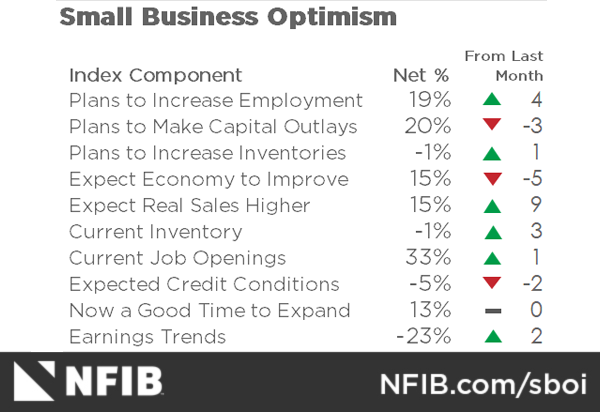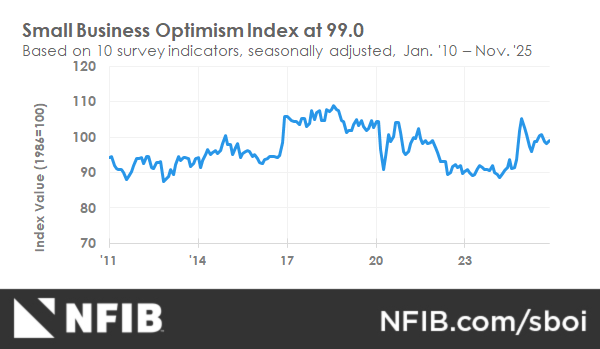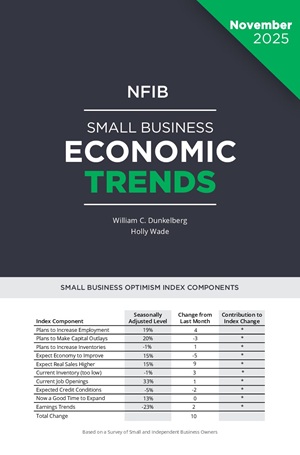Small Business Optimism Index
Small Business Optimism Index
Overview
The NFIB Research Foundation has collected Small Business Economic Trends data with quarterly surveys since the 4th quarter of 1973 and monthly surveys since 1986. Survey respondents are drawn from NFIB’s membership. The report is released on the second Tuesday of each month. This survey was conducted in November 2025.
November 2025: Small Business Optimism Edges Up in November
The NFIB Small Business Optimism Index rose 0.8 points in November to 99.0 and remained above its 52-year average of 98. Of the 10 Optimism Index components, six increased, three decreased, and one was unchanged. An increase in those expecting real sales to be higher contributed most to the rise in the Optimism Index. The Uncertainty Index rose 3 points from October to 91. An increase in owners reporting uncertainty about capital expenditure plans over the next three to six months was the primary driver of the rise in the Uncertainty Index.

“Although optimism increased, small business owners are still frustrated by the lack of qualified workers. Despite this, more firms still plan to create new jobs in the near future.”
NFIB Chief Economist Bill Dunkelberg
In conjunction with the November report, NFIB also released a new episode of the “Small Business by the Numbers” podcast. This is the NFIB Research Center’s new podcast where co-hosts Holly Wade, the Executive Director of the NFIB Research Center, and Peter Hansen, Director of Research and Policy Analysis, discuss the data, stories, and economic conditions affecting small businesses nationwide. Listen to the latest episode here.

In November, the net percent of owners raising average selling prices rose 13 points from October to a net 34% (seasonally adjusted), the highest reading since March 2023 and the largest monthly jump in the survey’s history.
 In November, 21% of small business owners cited labor quality as their single most important problem, down 6 points, erasing most of October’s sudden increase. Labor quality ranked as the top problem, 6 points ahead of inflation, which ranked second.
In November, 21% of small business owners cited labor quality as their single most important problem, down 6 points, erasing most of October’s sudden increase. Labor quality ranked as the top problem, 6 points ahead of inflation, which ranked second.
 The net percent of owners expecting higher real sales volumes rose 9 points from October to a net 15% (seasonally adjusted). This component contributed the most to the rise in the Optimism Index.
The net percent of owners expecting higher real sales volumes rose 9 points from October to a net 15% (seasonally adjusted). This component contributed the most to the rise in the Optimism Index.
 The average rate paid on short maturity loans was 7.9% in November, down 0.8 points from October and the lowest level since May 2023.
The average rate paid on short maturity loans was 7.9% in November, down 0.8 points from October and the lowest level since May 2023.
 When asked to evaluate the overall health of their business, 11% reported it as excellent (down 1 point), and 53% reported it as good (up 2 points). Thirty percent reported the health of their business as fair (down 3 points), and 5% reported it as poor (up 1 point).
When asked to evaluate the overall health of their business, 11% reported it as excellent (down 1 point), and 53% reported it as good (up 2 points). Thirty percent reported the health of their business as fair (down 3 points), and 5% reported it as poor (up 1 point).
 In November, 64% of small business owners reported that supply chain disruptions were affecting their business to some degree, up 4 points from October.
In November, 64% of small business owners reported that supply chain disruptions were affecting their business to some degree, up 4 points from October.
 The net percent of owners expecting better business conditions fell 5 points from October to a net 15% (seasonally adjusted). Expectations for better business conditions have fallen by 32 points since January.
The net percent of owners expecting better business conditions fell 5 points from October to a net 15% (seasonally adjusted). Expectations for better business conditions have fallen by 32 points since January.
As reported in NFIB’s monthly jobs report, a seasonally adjusted 33% of all small business owners reported job openings they could not fill in November, up 1 point from October and the first increase since June. Unfilled job openings remain well above the historical average of 24%. Of the 56% of owners hiring or trying to hire in November, 89% reported few or no qualified applicants for the positions they were trying to fill. A seasonally adjusted net 19% of owners plan to create new jobs in the next three months, up 4 points from October and the highest reading of the year. The last time hiring plans reached this level was in December 2024.
In November, 21% of small business owners cited labor quality as their single most important problem, down 6 points, erasing most of October’s increase. Fifteen percent of owners reported that inflation was their single most important problem in operating their business, up 3 points from October, making it the second biggest issue. Fourteen percent of small business owners reported taxes as their single most important problem, down 2 points from October. The percent of small business owners reporting government regulations and red tape as their single most important problem rose 3 points to 10%. Labor costs reported as the single most important problem for business owners remained at 8%.
Fifty-two percent of small business owners reported capital outlays in the last six months, down 3 points from October. Of those making expenditures, 37% reported spending on new equipment (up 1 point), 19% acquired vehicles (down 3 points), and 14% improved or expanded facilities (unchanged). Ten percent spent money on new fixtures and furniture (down 3 points), and 5% acquired new buildings or land for expansion (up 2 points). Twenty percent (seasonally adjusted) plan capital outlays in the next six months, down 3 points from October. Historically, this is a weak reading.
A net negative 9% of all owners (seasonally adjusted) reported higher nominal sales in the past three months, up 4 points from October. The net percent of owners expecting higher real sales volumes rose 9 points from October to a net 15% (seasonally adjusted). This component contributed the most to the rise in the Optimism Index.
The net percent of owners reporting inventory gains fell 1 point to a net negative 7% (seasonally adjusted). Not seasonally adjusted, 12% reported increases in stocks (up 2 points), and 18% reported reductions (up 3 points). A net negative 1% (seasonally adjusted) of owners viewed current inventory stocks as “too low” in November, up 3 points from October. A net negative 1% (seasonally adjusted) of owners plan inventory investment in the coming months, up 1 point from October.
In November, 64% of small business owners reported that supply chain disruptions were affecting their business to some degree, up 4 points from October. Seven percent reported a significant impact (up 3 points), 19% reported a moderate impact (up 2 points), 38% reported a mild impact (down 1 point), and 35% reported no impact (down 4 points).
Inflation is a point of concern in the November data. The net percent of owners raising average selling prices rose 13 points from October to a net 34% (seasonally adjusted), the highest reading since March 2023 and the largest monthly jump in the survey’s history. Price increases remain well above the monthly average of a net 13%, suggesting continued inflationary pressure.
Unadjusted, 39% reported higher average prices (up 8 points), and 8% reported lower average selling prices (down 4 points). Looking forward to the next three months, a net 30% (seasonally adjusted) plan to increase prices (unchanged from October).
Fifteen percent of owners reported that inflation was their single most important problem in operating their business, up 3 points from October and ranking second after labor quality.
Seasonally adjusted, a net 26% reported raising compensation, unchanged from October. A seasonally adjusted net 24% plan to raise compensation in the next three months, up 5 points from October.
The frequency of reports of positive profit trends rose 2 points from October to a net -23% (seasonally adjusted). Among owners reporting lower profits, 27% blamed weaker sales, 16% cited the rise in the cost of materials, and 12% cited labor costs. Nine percent reported usual seasonal change, and 7% cited price change for their product(s) or service(s). Among owners reporting higher profits, 51% cited sales volume, 18% cited usual seasonal change, and 12% cited higher selling prices.
A net 4% reported their last loan was harder to get than in previous attempts, down 1 point from October. In November, a net 2% of owners reported paying a higher interest rate on their most recent loan, up 1 point from October. The average rate paid on short maturity loans was 7.9% in November, down 0.8 points from October and the lowest level since May 2023. Twenty-three percent of all owners reported borrowing regularly, unchanged from October and a historically low level.
When asked to evaluate the overall health of their business, 11% reported it as excellent (down 1 point), and 53% reported it as good (up 2 points). Thirty percent reported the health of their business as fair (down 3 points), and 5% reported it as poor (up 1 point).
The net percent of owners expecting better business conditions fell 5 points from October to a net 15% (seasonally adjusted). Expectations for better business conditions have fallen 32 points since January.
In November, 13% (seasonally adjusted) reported that it is a good time to expand their business, unchanged from October. Compared to readings during economic expansions, this is a relatively weak reading.
The NFIB Research Center has collected Small Business Economic Trends data with quarterly surveys since the fourth quarter of 1973 and monthly surveys since 1986. Survey respondents are randomly drawn from NFIB’s membership. The report is released on the second Tuesday of each month. This survey was conducted in November 2025.


Labor Market
Most labor metrics improved in November. This month, 33% (seasonally adjusted) of all owners reported job openings they could not fill in the current period, up 1 point from October and the first increase since June. Unfilled job openings remain well above the historical average of 24%. Twenty-six percent had openings for skilled workers (down 2 points), and 12% had openings for unskilled labor (up 1 point). A seasonally adjusted net 19% of owners plan to create new jobs in the next three months, up 4 points from October and the highest reading of the year. The last time hiring plans reached this level was in December 2024. Firms remain interested in hiring but are finding it difficult to fill openings. Overall, 56% reported hiring or trying to hire in November, unchanged from October. Fifty percent (89% of those hiring or trying to hire) of owners reported few or no qualified applicants for the positions they were trying to fill (up 1 point). Thirty percent of owners reported few qualified applicants for their open positions (down 1 point), and 20% reported none (up 2 points). The last 12 months show a clear improvement in the hiring environment, with a growing percent reporting “few” relative to the percent reporting “none.” In November, 21% of small business owners cited labor quality as their single most important problem, down 6 points, erasing most of October’s increase. Labor quality ranked as the top problem and was 6 points higher than inflation, which ranked second. Labor costs reported as the single most important problem for business owners remained at 8%.
Capital Spending
Fifty-two percent of small business owners reported capital outlays in the last six months, down 3 points from October. Of those making expenditures, 37% reported spending on new equipment (up 1 point), 19% acquired vehicles (down 3 points), and 14% improved or expanded facilities (unchanged). Ten percent spent money on new fixtures and furniture (down 3 points), and 5% acquired new buildings or land for expansion (up 2 points). Twenty percent (seasonally adjusted) plan capital outlays in the next six months, down 3 points from October. Historically, this is a weak reading.
Inflation
Related to the aforementioned supply chain difficulties, inflation is a point of concern in the November data. The net percent of owners raising average selling prices rose 13 points from October to a net 34% (seasonally adjusted), the highest reading since March 2023 and the largest monthly jump in the survey’s history. Price increases remain well above the monthly average of a net 13%, suggesting continued inflationary pressure. Unadjusted, 39% reported higher average prices (up 8 points), and 8% reported lower average selling prices (down 4 points). Looking forward to the next three months, a net 30% (seasonally adjusted) plan to increase prices (unchanged from October). Fifteen percent of owners reported that inflation was their single most important problem in operating their business (higher input costs), up 3 points from October and ranking second after labor quality.
Credit Markets
A net 4% reported their last loan was harder to get than in previous attempts, down 1 point from October. In November, a net 2% of owners reported paying a higher interest rate on their most recent loan, up 1 point from October. The average rate paid on short maturity loans was 7.9% in November, down 0.8 points from October and the lowest level since May 2023. Twenty-three percent of all owners reported borrowing regularly, unchanged from October and a historically low level.
Compensation and Earnings
Seasonally adjusted, a net 26% reported raising compensation, unchanged from October. A seasonally adjusted net 24% plan to raise compensation in the next three months, up 5 points from October. The frequency of reports of positive profit trends rose 2 points from October to a net -23% (seasonally adjusted). Among owners reporting lower profits, 27% blamed weaker sales, 16% cited the rise in the cost of materials, and 12% cited labor costs. Nine percent reported usual seasonal change, and 7% cited price change for their product(s) or service(s). Among owners reporting higher profits, 51% cited sales volume, 18% cited usual seasonal change, and 12% cited higher selling prices.
Sales and Inventories
The two sales metrics were a bright spot in the November data. A net – 9% of all owners (seasonally adjusted) reported higher nominal sales in the past three months, up 4 points from October. The net percent of owners expecting higher real sales volumes rose 9 points from October to a net 15% (seasonally adjusted). This component contributed the most to the rise in the Optimism Index. The net percent of owners reporting inventory gains fell 1 point to a net -7% (seasonally adjusted). Not seasonally adjusted, 12% reported increases in stocks (up 2 points), and 18% reported reductions (up 3 points). A net -1% (seasonally adjusted) of owners viewed current inventory stocks as “too low” in November, up 3 points from October. A net -1% (seasonally adjusted) of owners plan inventory investment in the coming months, up 1 point from October. In November, 64% of small business owners reported that supply chain disruptions were affecting their business to some degree, up 4 points from October. Seven percent reported a significant impact (up 3 points), 19% reported a moderate impact (up 2 points), 38% reported a mild impact (down 1 point), and 35% reported no impact (down 4 points).
Outlook
When asked to evaluate the overall health of their business, 11% reported it as excellent (down 1 point), and 53% reported it as good (up 2 points). Thirty percent reported the health of their business as fair (down 3 points), and 5% reported it as poor (up 1 point). The net percent of owners expecting better business conditions fell 5 points from October to a net 15% (seasonally adjusted). Expectations for better business conditions have fallen 32 points since January. In November, 13% (seasonally adjusted) reported that it is a good time to expand their business, unchanged from October. Compared to readings during economic expansions, this is a relatively weak reading.
Single Most Important Problem
In November, labor quality ranked as the top problem for small business owners, 6 points ahead of inflation, which ranked second. The percent of small business owners reporting labor quality as the single most important problem for their business fell 6 points from October to 21%. Labor costs reported as the single most important problem for business remained at 8%. Fifteen percent of owners reported that inflation was their single most important problem in operating their business, up 3 points from October. Fourteen percent of small business owners reported taxes as their single most important problem, down 2 points from October. The percent of small business owners reporting government regulations and red tape as their single most important problem rose 3 points to 10%. The percent of small business owners reporting poor sales as their top business problem fell 1 point to 9%. In November, 10% reported the cost or availability of insurance as their single most important problem, up 2 points from October. Three percent reported that financing and interest rates was their top business problem in November, up 1 point from October. Three percent reported competition from large businesses as their single most important problem, down 2 points from October. The last time large business competition was this low was in June 2023.
Commentary
Overview
The economy has been doing reasonably well and so have small businesses. Consumer spending is solid, but the real driver of GDP growth is the massive level of AI investment spending, including investment in electricity generation. The administration is making substantial policy changes, elevating the level of uncertainty as owners wait for resolutions.
Owners have been frustrated by the lack of qualified workers available to fill their open positions. Job openings were above the historical average all year, compensation has increased, but few new workers were actually hired. Excluding government supported jobs, private sector job growth was weak. The most recent reported (Sept.) inflation rate was 3%, still above the Fed target but dramatically below the rate in 2022 that (peaked at 9.1%). “Affordability” continues to be a concern among many. The Fed will likely continue to allow interest rates to fall because of concerns related to the employment side of their mandate. Uncertainties will hopefully soon be resolved, and small business owners will feel more confident in making decisions about their business going into 2026.
Quotes from NFIB Members
“Steel and other supplies, welding, paint, grinding, cutting discs, and such are higher priced than ever, and despite the economic growth, they are not coming down.” – OH
“We can’t expand due to lack of raw materials and employees.” – WI
“Steady increase in pay over the years. We hire a ton of college students, and it works out wonderfully. High school students as well. Struggling to find full-time employees who will stay for more than one year. I am struggling with finding management and good, responsible employees who don’t have other responsibilities. Labor costs are always high- 35% on average or more.” – MO
“The general cost of goods and materials has significantly increased consistently since 2020. Payroll taxes are higher, and insurance is almost impossible to afford – health, liability, and workers’ compensation. Taxes in general have increased (state and local) and our property taxes have an itemization for tax codes a mile long. California is slowly suffocating and is in desperate need of help. Many businesses, such as ours, have already closed. I fear that unless there are more positive incentives, tax breaks, cuts, and affordable costs in materials, many more will close, relocate, downsize, or leave the state.” – CA
“Labor needs are never met. The quality of workers is very poor.” – FL













